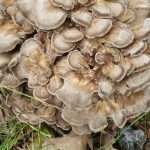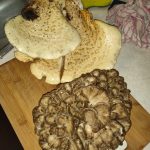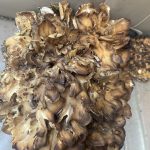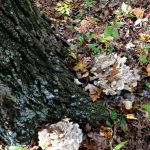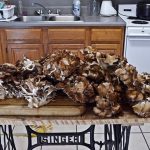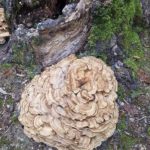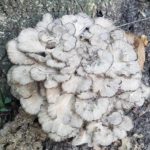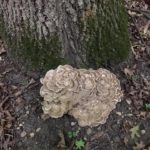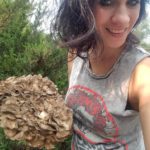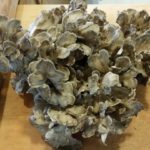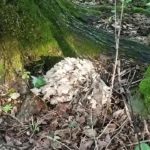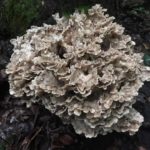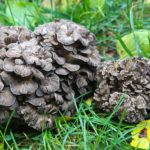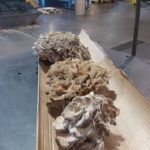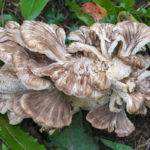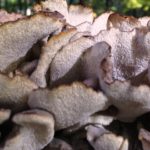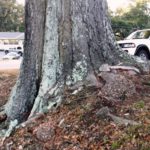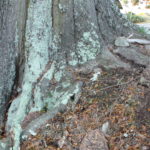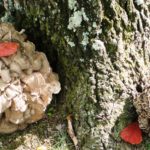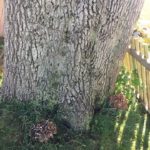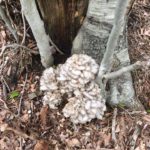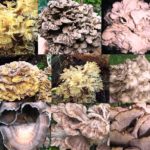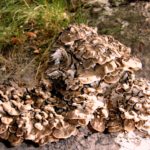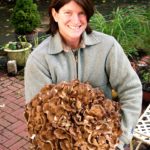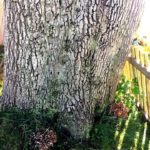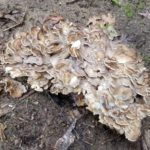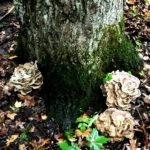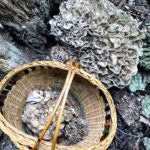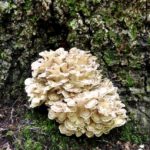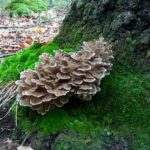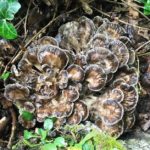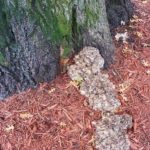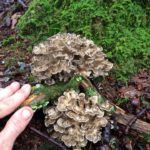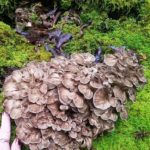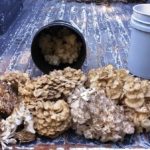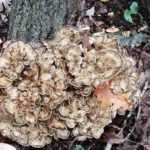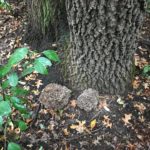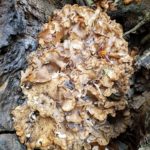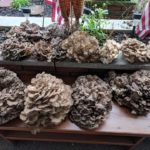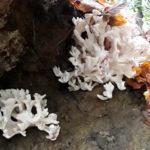Hen of the Woods (Grifola frondosa) (Maitake)
- Newly Added
- Photos
- Growth
- Videos
- Description
- Look Alikes
- Medicinal Info
- Drying and Freezing
- Recipes
Newly added content:
During our fall 2019 Georgia foray, we found a record-sized Hen of the Woods! At first we knew it was large but thought it might be 20+ pounds, that is until we picked it up! It ended up being 42 pounds which is the largest Hen I have ever found in the state of Georgia. (I have a 51 pounder found in Indiana 10 years ago…) This was an amazing find right on a main road in downtown Douglasville, GA found during my guided fall foray here just before Thanksgiving this year in 2019. Overall however, many of my marked trees from previous years find had none in most cases and was a very poor year here in GA. My fall forays in Illinois, Indiana, and Ohio also had very lower than average finds probably due to the very late extended heat wave and dry spell the entire month of September…
New pics added 12-31-2019:
Original Photo Gallery:
Newly added photos 8/28/2018:
More new hen pics added 10/29/2018:
HOTW’s Growth:

More Growth Photos added 10/29/2018:

Rare “Inverted Pores” White “Sheep’s Head”



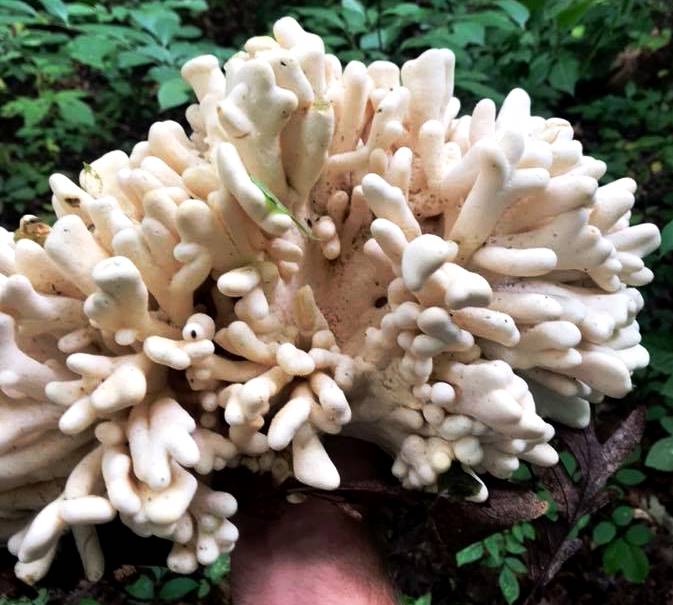


Above: Once-in-a-lifetime find: An “Albino” Hen of the Woods!
OMG! Another Albino fruiting in September, 2018:
2018 is the year for albino hens! More pics added 10/29/2018:
Description:
Grifola frondosa is a polypore mushroom that grows in clusters at the base of trees, particularly oaks. The mushroom is commonly known among English speakers as hen of the woods, hen-of-the-woods, ram’s head and sheep’s head. It is typically found in late summer to early autumn. In the United States’ supplement market, as well as in Asian grocery stores, the mushroom is known by its Japanese name maitake (舞茸, “dancing mushroom”). Throughout Italian American communities in the northeastern United States, it is commonly known as the signorina mushroom. G. frondosa should not be confused with Laetiporus sulphureus, another edible bracket fungus that is commonly called chicken of the woods or “sulphur shelf”. Like all polypores, the fungus becomes inedible when older, because it is then too tough to eat.
The fungus is native to China, the northeastern part of Japan and North America, and is prized in traditional Chinese and Japanese herbology as a medicinal mushroom. It is widely eaten in Japan, and its popularity in western cuisine is growing.
Like the sulphur shelf mushroom, G. frondosa is a perennial fungus that often grows in the same place for a number of years in succession. It occurs most prolifically in the northeastern regions of the United States, but has been found as far west as Idaho.
G. frondosa grows from an underground tuber-like structure known as a sclerotium, about the size of a potato. The fruiting body, occurring as large as 100 cm, is a cluster consisting of multiple grayish-brown caps which are often curled or spoon-shaped, with wavy margins and 2–7 cm broad. The undersurface of each cap bears about one to three pores per millimeter, with the tubes rarely deeper than 3 mm. The milky-white stipe (stalk) has a branchy structure and becomes tough as the mushroom matures.
In Japan, the maitake can grow to more than 100 lb (45 kg), earning this giant mushroom the title “king of mushrooms”. Maitake is one of the major culinary mushrooms used in Japan, the others being shiitake, shimeji, and enoki. They are used in a wide variety of dishes, often being a key ingredient in nabemono or cooked in foil with butter.
Oaks:
Above: Live Oak near Atlanta. In the south, big live oaks are the place to look. Southern Indiana for example, Black Oaks are their favorite where in Ohio near Columbus, it’s usually White Oaks.
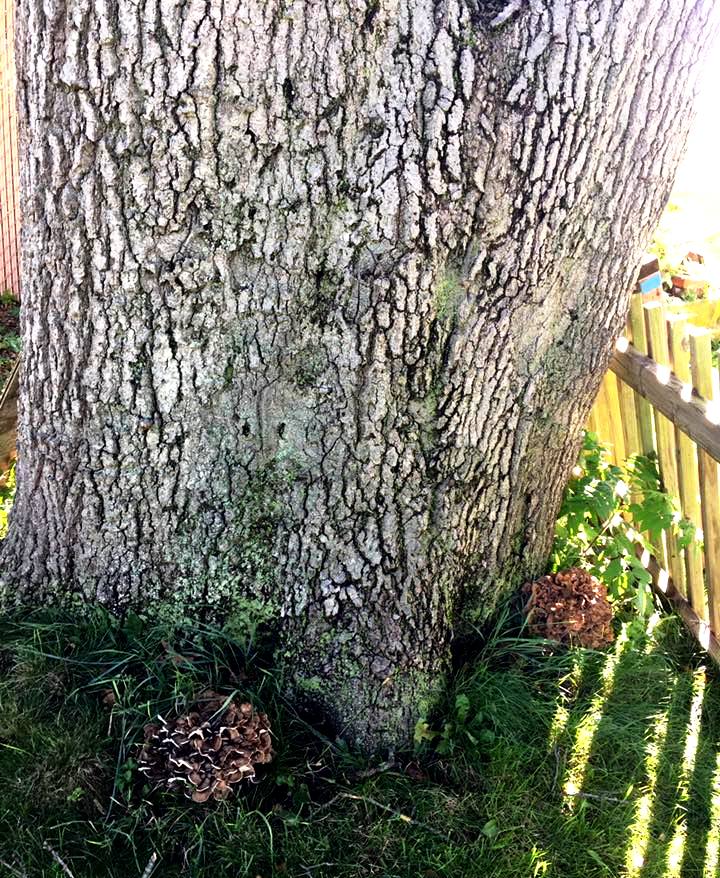
Above: White Oak in Ohio…

Above: Black Oak in Brown County, Indiana…

Above: A large “dead” Red Oak in Minnesota…
Stumps:
Beech:
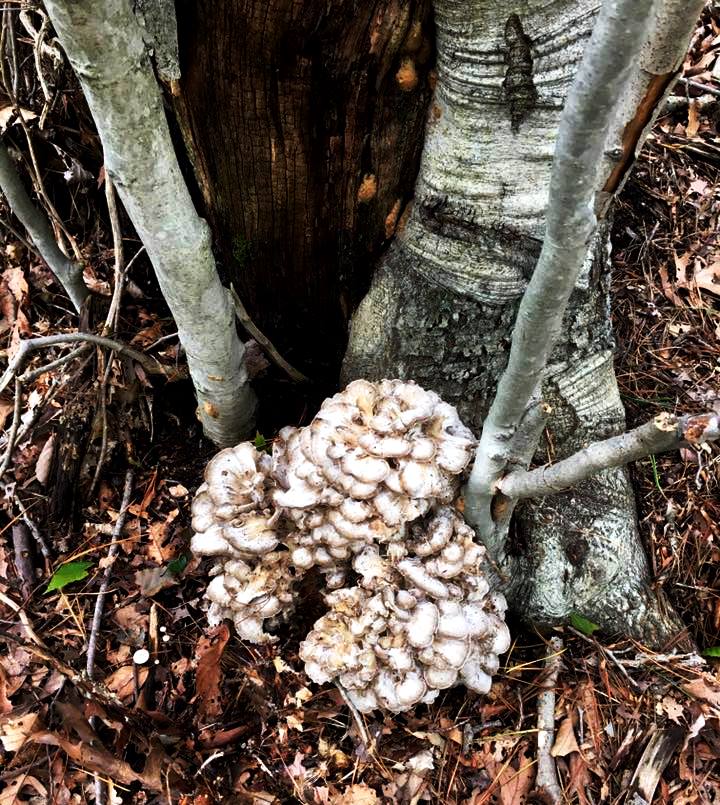

Maple (very rare):

Log:(rare)

Commercially Cultivated:

Videos:
Look Alikes:
People, especially newbies, often mistake chicken of the woods, black staining polypore, and berkeley’s polypore for hens…
Medical research and use:

In 2009, a phase I/II human trial, conducted by Memorial Sloan–Kettering Cancer Center, showed maitake could stimulate the immune systems of breast cancer patients. Small experiments with human cancer patients have shown it can stimulate immune system cells, such as NK cells. In vitro research has also shown G. frondosa can stimulate immune system cells. An in vivo experiment showed that it could stimulate both the innate immune system and adaptive immune system. In vitro research has shown maitake can induce apoptosis in various cancer cell lines, and inhibit the growth of various types of cancer cells. Small studies with human cancer patients revealed that a portion of this mushroom, known as the maitake D-fraction, possesses anticancer activity. In vitro research demonstrated the mushroom has potential antimetastatic properties. Maitake has a hypoglycemic effect, and may be beneficial for the management of diabetes. It lowers blood sugar because the mushroom naturally contains an alpha glucosidase inhibitor. This species contains antioxidants and may partially inhibit the enzyme cyclooxygenase. An extract of maitake inhibited angiogenesis via inhibition of the vascular endothelial growth factor. Lys-N is a unique protease found in maitake. Lys-N is used for proteomics experiments because of its protein cleavage specificity.
Drying and Freezing:
Dries and freezes excellent, as well as pickling…
Recipes:






